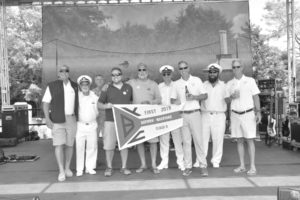By David Fleet
Editor
At 5:37 p.m., Monday, July 22 the Flying Buffalo and crew sailed into the Straights of Mackinac following a two day Great Lake gauntlet featuring fickle wind, rain and lighting. 
On deck of the 36-foot sailboat was Atlas Township attorney and veteran sailor David Lattie who reflected on the Flying Buffalo’s trek during the 95th edition of the 2019 Bell’s Beer Bayview Mackinac Race. The race from just north of the Blue Water Bridge in Port Huron to Mackinac Island covers about 200 nautical miles. The longest consecutively run freshwater race in the country started July 20 with 202 boats sailing away at staggered times. This year the fleet, represented nine states in the U.S. and two provinces in Canada, was divided into 20 classes in three divisions.
The Flying Buffalo finished first in Class R with 13 boats and 13th overall in Class II with an elapsed time of 52:37:27 and a corrected time of 36:50:12.
Lattie recalls a few miles off the Thumb near Saginaw Bay early in the race.
“We got off the start line pretty well,” said Lattie. “The wind was coming from our side. An angle the Flying Buffalo does pretty well with. About Port Sanilac the fleet slowed down. We could see the storm coming down on us. Along the Thumb of Michigan, there’s a lot of farming country, the land heats up dramatically and the lake does not. As a result there’s a lot of lighting, a lot of rain, a lot of wind. We had all those things. We waited for the storm to pass then for the wind to settle in and it did but it was from the north, which for the Flying Buffalo was not a great direction.”
The wind shift moved the Flying Buffalo from first place in the fleet to about fourth place with two-third of the race to go.
Port Huron to Mackinac racers typically follow one of two courses; the Shore Course, which follows a few miles from the eastern Michigan Shoreline, 204 nautical miles or the Cove Island Course, 253 nautical miles, which crosses Lake Huron toward Cove Island, Ontario then back west to Mackinac. The Shore Course race is about 5 miles out, except when the boats cross Saginaw Bay. The boats are in visual contact for most of the race and often dodge freighters during the two days of the course.
“We were disappointed,” he said. “The upwind is not our strong suit. You have to tack—about 45 degrees to the wind. More modern boats can sail 35 degrees to the wind as a result move up the lake faster then we can.”
Tacking is a sailing maneuver that turns the bow of the boat through the wind so that the wind changes from one side of the boat to the other side.
We did not have much hope at that point, said Lattie.
“The wind then just died,” he said. “At one point we were going zero knots.”
North of Thunder Bay near Alpena the winds changed and the Flying Buffalo made up some ground of the fleet.
“Men and women that have raced the Mackinac many times tend to do better at night,” he said. “Sailing at night is hard, you have to rely on the feel of the boat rather than looking at a wind instrument or looking at how the sails trim or the waves patterns. You can feel the angle of the wind and the angle of the waves.”
The Flying Buffalo is owned by Al Declercq of St. Clair Shores who was in his 53rd Mackinac race. The crew included Bob Declercq, Charles Stormes, Robert Declercq, Ken Flaska, David Lattie and Lyndon Lattie. The Flying Buffalo had won the Bayview Mackinac race in 1964, 1967, and 1968, the Chicago Mackinac overall in 1966 and 1967, and the Mills overall in 1966, 1967, and 1968 with truly a break through boat design. Asian boat builder Cheoy Lee eventually bought the design. They sold it as the Offshore 36 with over 1,000 copies of it shipped around the world and another 100 copies shipped to the US.
Because the Declercq family had sailed so many Mackinac races it made a big difference at night and the boat surged ahead of the fleet, said Lattie.
“You know the old saying, ‘You don’t like the weather in Michigan, wait five minutes,” he said. “Great Lakes weather forecasts are notoriously fickle. The first night on the water was beautiful. The second night there was lots of wind with waves coming over the bow. It was also very cold on Sunday night. My biggest concern was staying warm so I had on all my warmest foul weather gear. The water temperature is about 60 degrees up there, add to that a 30 mile per hour wind. You’re also wet so hypothermia can happen real fast. It’s surprisingly cold in the summer.”
Many boats dropped out Sunday night, he said.
“This race is unique due to the competition,” he said. “The weather is always a factor. It can be really slow or very challenging. The combination make it interesting. Unlike some of the big ocean races, there’s more of a family atmosphere in the Mackinac. It’s very user friendly. The enthusiasm of people that are just getting into sailing, and families for the first time is awesome. When they finish this race they are going to have a story to tell. Everyone accomplishes something—if it’s your first race there’s no better feeling then crossing that finish line a little bit tired and a little bit proud you did something you did not think you could do.”
